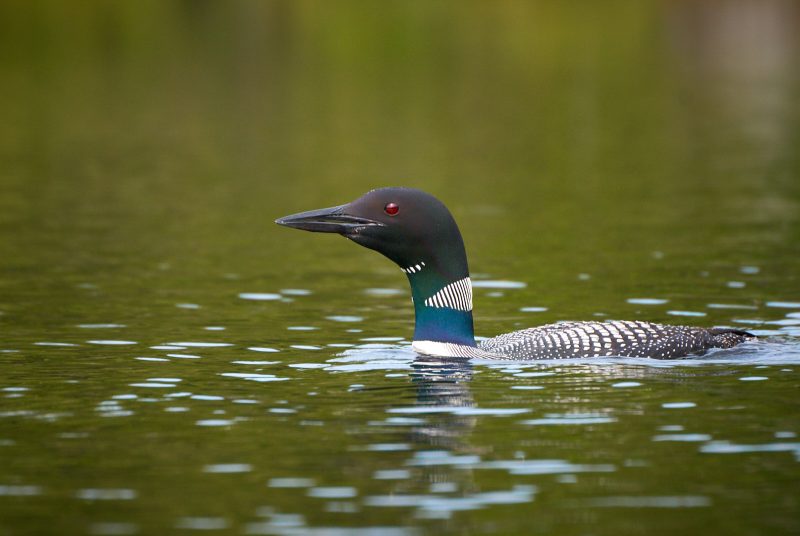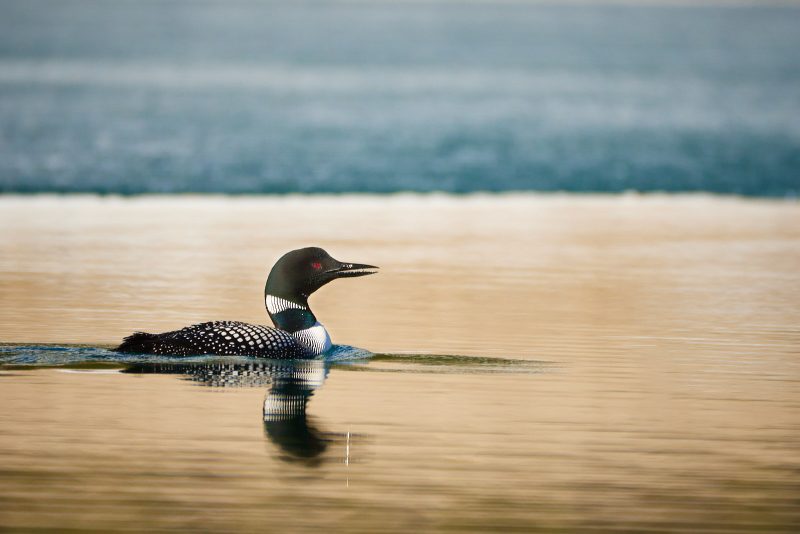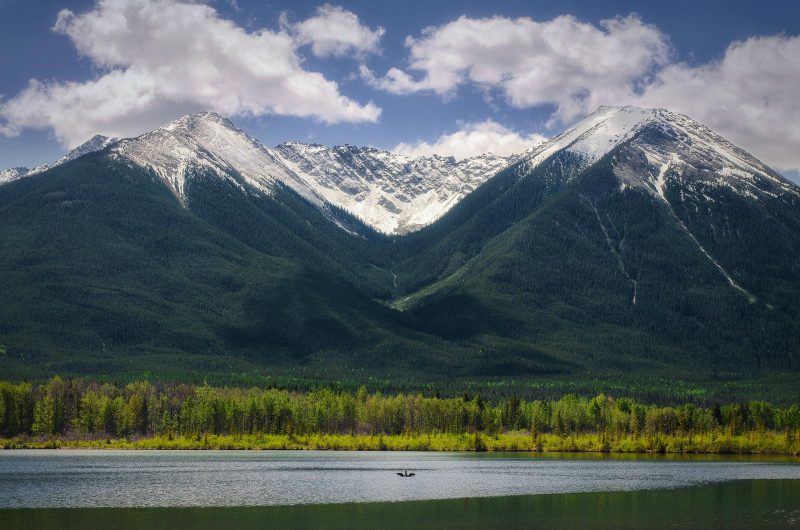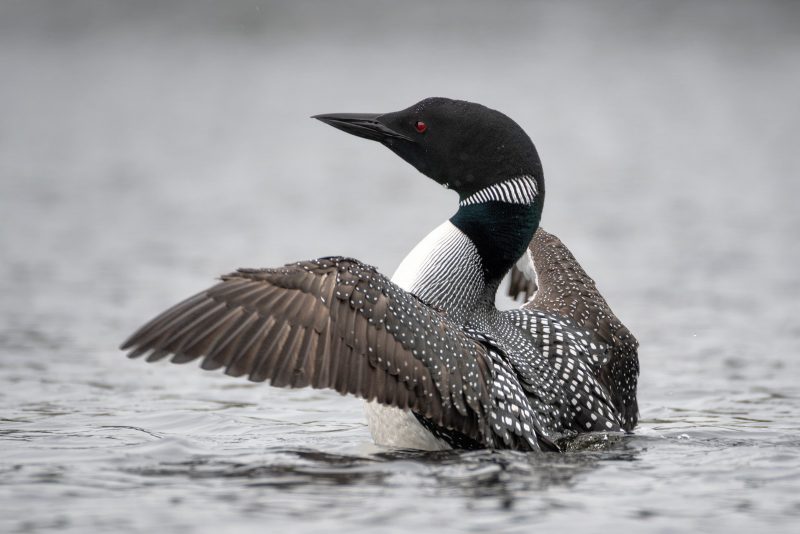How to Photograph Loons
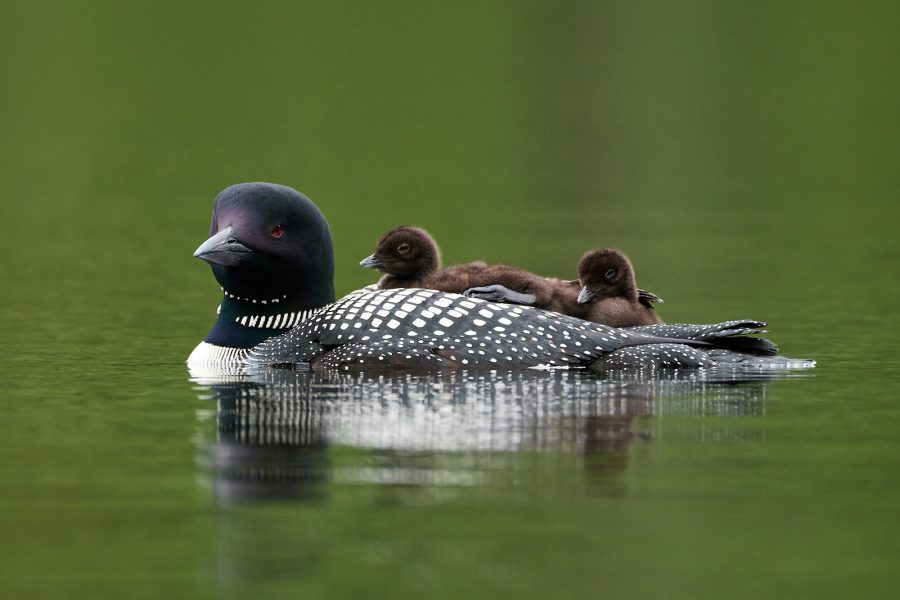
There are few sounds in nature that conjure thoughts of wilderness and solitude like the haunting, wolf-like call of the common loon. Every spring, photographers travel to remote North American lakes in hope of photographing adult loons in striking black-and-white breeding plumage, with their adorable chicks hitching a ride on their parents’ backs.
In addition to the common loon, there are four other species of loons (also known as divers), spread out around the northern latitudes of North America and Eurasia: the red-throated loon, Arctic loon, Pacific loon, and yellow-billed loon.


The habits of the Arctic, Pacific, and yellow-billed loon are all very similar to those of the common loon, with which I have spent all my time. However, the red-throated loon is somewhat of a rebel and behaves differently to other loons in many ways.
This guide will provide you with general tips and tricks to help get the perfect shots of all five species, as well as some photogenic behaviors for which to keep an eye out.
Where to find loons
Loons breed in freshwater lakes and large ponds in northern North America, Europe, and Asia. They generally prefer clean and clear bodies of water with minimal human presence, and will avoid water that is too polluted or murky for them to effectively hunt.
With the exception of red-throated loons, who are small and light enough to take off without a running start, the bodies of water that loons nest on have to be large enough to provide them with a runway to gain enough speed to take off. The red-throated loon is also the only loon that will not forage for food on its home lake, but will instead fly to distant lakes or the ocean to find food for their chicks.
When to photograph loons (and what to expect in each season)
Like many birds, loons have distinct breeding and non-breeding plumage. The non-breeding plumage, visible in the late fall and winter, is a much more muted grey and white pattern, while the breeding plumage has bold black and white patterns, accented with grey, red, or green iridescence (depending on the species).
In the non-breeding season, loons migrate to the nearest ocean or large body of unfrozen water. Although there is never a bad time to photograph loons, the best results will come from photographing them on their breeding grounds when their plumage is the most dramatic.
Spring
The beginning of breeding season in the early spring offers plenty of drama to photograph. The loons generally start returning as soon as their lakes begin to thaw. Loons (with the exception of the red-throated loon) are very territorial, which leads to a lot of competition for prime nesting spots. Small lakes will usually only have one pair of loons, while larger lakes will have two or more pairs that occupy different areas.
The resident loons will fight to protect their territory: confrontations between males can become very violent, and are often fatal. If you’re lucky enough to be in the right place, you can capture some very dramatic images as the loons chase each other around.
As red-throated loons are generally less territorial than other loons, several pairs may nest communally if there aren’t many suitable lakes or ponds near to their feeding grounds.
On the more tender side of the behavior spectrum, early spring is also when courtship, pair bonding, and copulation occurs. Once the eggs are laid, both the male and the female take turns at incubating the eggs for about 28 days. Due to the placement of their legs – very far back on their bodies – loons are very clumsy on land, and as a result build their nests very close to the shore.
While this can result in some very visible nests, care should be taken during this time to only photograph the loons from a great distance with telephoto lenses, in order to avoid causing stress or abandonment of the nest.
Read more: How to Photograph Nesting Birds
The most exciting time to photograph loons is when the chicks hatch. The chicks emerge covered in fluffy down and leave the nest within a few hours of hatching. The adults bring the young to a sheltered nursery area, where they’ll spend most of their time for the first few weeks.
It’s during these first two to three weeks that you’ll be able to see the chicks ride on the backs of their parents, often climbing underneath a wing to warm up. This is an incredibly cute sight, as the chicks will often yawn or stretch their wings as they prepare for a nap. The parents constantly bring them small fish and invertebrates, which creates many opportunities to get an image of the handoff between the adult and the chick.
Note: In the UK, all diver species are protected under Schedule 1.
Summer
As the chicks grow, the parents will gradually start leaving them alone for short periods while they hunt. By midsummer the chicks will start attempting to hunt for themselves, as they will need to be completely self-sufficient before their parents leave them in the fall.
As summer progresses, you’ll be able to photograph the chicks as they develop their juvenile plumage and slowly grow to nearly the size of the adults.
Throughout the breeding season, other loons will visit the lakes of breeding pairs to determine its suitability for breeding. Scientists believe that these ‘floater’ loons use the presence of chicks as an indicator of a lake’s quality, and will return the next spring in an attempt to win the lake from the resident pair.
Fall
The resident loons will perform threat displays, make aggressive vocalizations, and attempt to chase off the visitors, which can make for some exciting images. However, in the fall the adults seem to lose their territoriality, and will form groups with other adults before beginning their migration back to the ocean. This provides an excellent opportunity to photograph large groups of adults all at once.
The adults leave the breeding grounds a few weeks before the juveniles, who sometimes remain at their home lakes until ice starts to form. Eventually, they all make their way out to the wintering grounds along the coast, where they spend the coldest months hunting for food and waiting for the cycle to begin anew in the spring.
Photographic opportunities are less plentiful here, as access to the ocean is more limited, and the colder weather makes being on the water rather unpleasant for most people.
Winter
However, winter is an excellent time to look for species of loon that don’t breed in your area, as their wintering ranges tend to be more spread out, and range much farther south than during the breeding season.
Unfortunately, many of the species look very similar in their non-breeding plumage, so there can be a lot of confusion about what species you’re actually looking at.
Equipment for photographing loons
Loons are large enough that you’ll be able to create images of them with a wide variety of equipment. Here are six pieces of equipment that you might want to have in order to maximize your photographic opportunities:
1. A boat
A boat will vastly improve your mobility, and will allow you to get yourself in the perfect location to capture the action. Kayaks and canoes are generally the most popular options because of their small size, portability, and affordability, but small fishing boats with electric motors can also be useful if there is a boat ramp at the lake.
A pedal-drive kayak can be especially useful, as it allows you to navigate without having to put your camera down.
2. A floating blind
Depending on your location and the tolerance of the resident loons, a floating blind can be an excellent platform from which to photograph. A floating blind will allow for a lower shooting angle, without the awkward gymnastics that are required for eye-level photography in a boat.
They can be particularly effective if photographing a nest (from a safe distance, of course) or if you don’t need the mobility of a boat, as you can remain completely hidden and stationary.
3. A telephoto lens
A telephoto lens will be one of your most important pieces of gear in your quest to photograph loons. This will allow you to compress the scene and, most importantly, give the loons the space they need to feel comfortable. Telephoto zooms like a 150-600mm are great options, as they provide flexibility that you’ll appreciate when a loon unexpectedly pops up 15 feet from your boat.
If you have two camera bodies (and space in your boat), mounting a long prime lens (500mm or 600mm) on one body and a telephoto zoom like a 100-400mm on the other can provide you with options for almost any situation. Lenses with image stabilization will help smooth out some of the unsteadiness you’ll get from photographing from an unstable platform, such as a kayak.
Read more: What’s the Best Lens for Wildlife Photography?
4. A dry bag
You will definitely want to store your camera in a waterproof dry bag whenever you’re not shooting. The last thing you want is for your camera to get soaked by a wave splashing against your boat, or for it to get dunked in the water if you’re less than graceful getting in or out of your boat.
5. Spare batteries and memory cards
These should be in every photographer’s bag. It would be a nightmare for your card to fill up, or for your only battery to die, right as a chick climbs on its mother’s back.
Large memory cards can be beneficial here, in order to minimize the risk of dropping a memory card into the lake while replacing a full card.
6. An underwater camera
This is a completely optional piece of equipment, but one that could yield extremely exciting results if the loons are comfortable enough to swim right around your boat.
Tips and tricks for photographing loons
Now that you’re fully equipped, here are ten tips and tricks to help you capture the perfect loon images that you’ve been hoping for:
1. Put in the time
The best tip for successfully photographing loons (or any wildlife really) is to spend a lot of time studying your subjects and learning to predict their behaviors. If you are fortunate enough to live close to a loon-inhabited lake, this means making lots of trips out and taking note of what can lead to certain behaviors.
This will also have the added benefit of allowing your local loons to get comfortable with you and your boat. There are anecdotes of loons leaving their chicks with photographers for a bit of babysitting while they go off to hunt, which will obviously only happen if the loons have complete trust in you.
2. Get low
This can be a little tricky depending on where you’re photographing the loons from, and can require some contortions and careful balancing. However the results are certainly worth it, as you get a beautifully blurred background behind the birds, and the eye-level perspective that makes images more engaging.
3. Make sure the eyes are sharp
Humans like to make eye contact with everything, and loons have very dramatic red eyes that immediately draw your attention. So make sure those eyes are perfectly in focus for maximum impact.
Read more: The Real Reasons Your Photos Aren’t Sharp
4. Go slow and be patient
Even loons who are accustomed to boaters in their lake won’t appreciate it if you come speeding right up to them. Instead, slow down while you’re still a fair distance away and try to put yourself where they will be, rather than following them around.
Loons often work their way along a shoreline or through a favorite hunting area, so you’ll be rewarded with a lot of head-on images if you place yourself ahead of them and wait for them to come to you.
5. Minimize paddle use
You will find that loons who are comfortable with you and your boat can get suddenly nervous when you start paddling, especially if you’re using double-bladed paddles. One possible explanation for this is that paddles might resemble wings, which makes you look like a large, threatening bird when you start moving them.
Try to keep your paddle use to an absolute minimum and, if you must use them, do so slowly and keep your paddles as low to the water as possible.
6. Pay attention to the weather
Learn how to predict when those extra special conditions will occur, and time your trips to coincide with those conditions. For example, mist can elevate images in any area of photography, and loon photography is no exception.
7. Experiment with lighting
Loons have very distinct silhouettes and make excellent subjects for backlit photos (especially when you’ve carefully timed your visit to coincide with a nice light mist).
Morning and evening light will give you a lovely warm glow, and soft, overcast light during the day can make it easier to accurately expose for the blacks and whites of the loons’ feathers. This leads well onto to my next tip.
8. Keep an eye on your histogram
Due to the fact that loons have both black and white feathers, it can be very tricky to photograph them without blowing out the white feathers, or causing a lot of noise in the black feathers (especially in bright light).
I try to keep the ISO as low as possible to preserve dynamic range, while still allowing me to maintain fast shutter speeds.
Read more: Understanding Histograms and How to Use Them
9. Think creatively
It is likely that you will get a nice static pose very quickly upon arriving at a lake. Once you have that shot in the bag, you can start experimenting and trying to create more unique images. Try to photograph different behaviors, like food transfers and wing flap displays.
Also, don’t be afraid to zoom out and show the loon as a part of its landscape. Due to their preference for relatively wild lakes, the surrounding scenery tends to be fairly photogenic, especially in mountainous regions.
10. Don’t stress the loons
The safety and well-being of the loons should be your top priority. If the loons are reacting negatively to your presence, either back off or leave altogether.
You will get far better images with calm and relaxed loons than with loons who are agitated by you.
Photogenic loon behaviors
I have already mentioned a few behaviors that tend to make for excellent photographs. Here are some ways to predict when these behaviors might happen:
1. The wing flap
This is the quintessential loon photograph, and luckily a behavior they exhibit frequently. It can occur during and after preening, after a series of dives, and also as a territorial threat display towards other loons (or you, if you approached too quickly).
2. Chicks on their parents’ backs
When the chicks are very young, they aren’t able to stay warm while swimming for long periods of time. Riding on their parents’ backs allows them to warm up and rest, and also protects them from predators. Keep an eye on the parents’ wings, as sometimes you’ll find a tiny head poking out from between the feathers.
Occasionally, the young will be unceremoniously dumped off the back if the parent decides that it is time for some hunting. (Note: red-throated loons are once again exhibiting their rebellious side and do not carry their young on their backs).
3. Food transfers
This behavior is very easy to predict, even if it can be difficult to photograph. The parents will approach the chicks with a small fish, crayfish, or another tasty aquatic morsel, and attempt to give it to them.
When the chicks are very young this tends to be a bit of a process, and it can take a few tries for the chick to finally swallow the food.
Occasionally, the adults will bring something that is far too large for the chick to handle, and will usually end up eating it themselves after watching the chick struggle to swallow it.
Keep an eye out for interesting details, like crayfish with their claws removed to protect the young. These transfers become more efficient as the chicks grow.
4. Territorial fights
Nesting loons are constantly putting up with unwanted visits from other loons, and have to resort to a number of measures to get them to leave.
These fights can be hard to photograph as they frequently involve a lot of diving and underwater chases, in addition to being generally fast moving and difficult to keep up with. If you happen to be in a good spot, have your camera set with a fast shutter speed to freeze the action.
In conclusion
Photographing loons is a very exciting and satisfying photographic endeavor. Not only do you get to spend time with a very charismatic bird, you get to do so while enjoying the solitude of a wilderness lake.
The fluffy chicks are about as cute as they come, and the inherent curiosity of loons will give you plenty of chances for close-up photos, once they’re comfortable with you.
So, good luck! And finally, don’t forget to take some time without your camera to enjoy the whole experience and appreciate these iconic birds.










